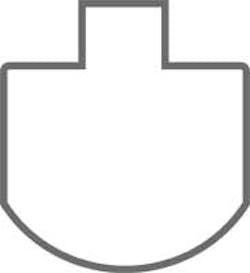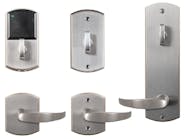By the time this article is published, the first major changes to mailbox regulations in more than 30 years will have taken effect. The essence of the new regulations basically comes down to new multi-unit mailbox units with new lock and construction standards. These changes become mandatory for new construction and major remodels in October 2006.
All new boxes must comply with the new high security regulations. The typical vertical style mailboxes, styles 4B and 4B+, will be grandfathered in. The new boxes will be much larger and may no longer be mounted vertically. They will all be horizontal and must have a parcel locker for 10 or more units.
The parcel lockers will have a two-key system that will allow the mail person to drop a parcel locker key in the mail recipient's box so he or she can gain access to the parcel locker.
Size & Weight: A typical 10-unit box will be 31-1/8 inches wide by 34 inches high by 17 inches deep, which includes the mandatory parcel locker and weighs 100 pounds. A typical 16-unit mailbox locker will be 31-1/8 inches wide by 51-1/2 inches high and 17 inches deep and include two parcel lockers, weighing 130 pounds. All mailbox units from three on up must have an outgoing mailbox.
Existing vertical-style mailboxes are only 7-1/2 inches deep, so the new depth of 17 inches will be a major change and most likely cause some serious construction issues.
Parcel Lockers: The new 4C regulations require at least one parcel locker for every 10 units.
Outgoing Mail Collection: A compartment equivalent to two 3-1/4-inch high tenant doors is used for outgoing mail collection. These are required even in a three-mailbox unit.
Construction: The entire mailbox units are made of a heavy gauge aluminum. The new boxes must survive a five-minute attack and take in a "noise factor." This seems a little presumptuous on the part of the Post Office. The noise factor basically means that a major attack might be so noisy, whatever that means, to attract attention and alert passersby or residents to call the authorities.
Cluster Box Units (CBUs) must meet the performance specs as of October 2006. CBUs are those usually large units that are on a pedestal or under an enclosure, out of the elements and not in a building foyer. These units are usually supplied by the Post Office.
At the present time, Florence is the only company meeting the various new 4C specifications. Commercial boxes such as we see inside apartment buildings and sold by locksmiths will be meeting the 4C specs within 12 months. The doors must meet a 250-pound pull test, which is far superior to existing doors.
The Postal Service doesn't appear to care how the various manufacturers meet the various tests as long as they meet the size, poundage and attack specifications. As an example, if a mailbox manufacturer could come up with an inexpensive way to have a three-point lock on a thinner door that would meet or exceed the specs, the Postal Service would be happy. The cost per unit to stay competitive and still comply with the new regulations is the driving force behind design.
LOCKS & KEYs
As of today, CompX is the only company authorized to manufacture and sell these locks. They could be sold by other companies such as Wind or Bommer, but they are manufactured to postal specifications only by CompX National. For more information, visit the CompX web site at compx.com and look under CompX National's products section or visit the USPS web site at http://ribbs.usps.gov/files/fedreg/usps2004/04-8972.txt. Additional information can be found at www.mailboxes.com.
Old Lock
- Double D cutout
- Will not fit into new style
- Flat top cylinder collar
- National logo on the face of the cylinder
- Die cast metal plug housing
- Must have fixed or staked cams
- CBUs have a weather shutter
- Comes with cams
- Cams are steel
- Comes with two keys
- A number of keyways and cylinders
- C8710-C8735
- Spring clip
- No moisture drainage holes
- Codes available
- Various code series, i.e. BN1288 or 4015PO
- Old boxes labeled 4B or 4B+
- Cam withstands 100 lbs. pull
- Some models have dust/rain shield
New Lock
- Modified Double D cutout
- Will fit into the new and old styles
- Tapered 12 degree cylinder collar
- USPS-L-1172C on the face of the cylinder
- Now able to handle up to a 3/16-inch thick cam
- The C9100 will come without a cam
- Cams are stainless steel
- Comes with three keys
- Two new keyways, 1,000 changes each
- D4300 & D4301, Ilco # 1646 & 1646R
- Spring clip
- Drain holes on bottom of cylinder
- Codes will not be released
- D4300 codes 1000-1999 and 3000-3999, D4301 codes 2000-2999 and 4000-4999
- Dust/rain shield required
Locks and key blanks are available through your local supplier. Original keys as stated above are D4300 and the reverse D4301. Ilco's numbers are 1646 and the reverse, 1646R. Costs on the original blanks are in the range of 94 cents each and the costs on the Ilco blanks are in the range of 42 cents each. The locks, without cams, cost approximately $6.89 each.
The new locks, which are superior in construction and security, have one visible flaw. If the intent is for locksmiths to use these new locks in place of the old ones, then why not sell multiple cams or cam packages that will allow us to install the new locks in place of the old mailbox locks currently in use? The USPS seems to have only thought this part through by making the locks work in old units without giving us the tools to actually do it. I'm sure some wise manufacturer will come up with a cam package to fulfill the expected need. At the time of this writing, CompX is working on this very project.
These regulations come after one of the greatest multiple housing construction periods in our history. With the much greater security offered by these new regulations, it is unfortunate that they were not adopted 30 years ago or even 10 years ago. Hopefully, we will see a gradual reduction in thefts from mailboxes.





